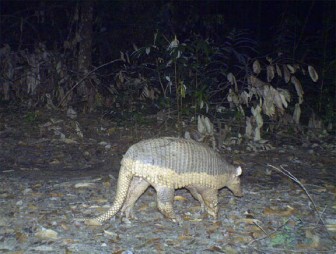One of the Giants of Eldorado, the Giant Armadillo (Priodontes maximus) is the largest of the armadillos, and weighing in at 26 kg (approximately 57 lbs), is truly deserving of its name.
This neotropic giant ranges from north of Brazil, Paraguay, southern Venezuela, the Guianas and the extreme north of Argentina, but regardless of their large range, they are rare in number. In Guyana they inhabit savannah and rainforest and have a preference for watery areas, forest islands, bushlands and woodlands. They are generally rare in their range and their habits and low population make them difficult to see. Both photographs for this article were taken with camera traps, one in the Iwokrama Forest and the other in the Kanuku Mountain Range.
The body of the Giant Armadillo is armoured with bony scales which are dark brown in colour for the most part; the armour is joined by flexible bands of tough skin; about 11-14 at the back and about 3 to the front. The head, tail, legs and the edge of the carapace appears yellowish in colour; each front leg has 3 large claws, while the tail and legs are covered with tough pentagonal scales. The head is conical and is protected by dome shaped armour with prominent leaf shaped ears on the top sides of the head.
Giant Armadillos are terrestrial, nocturnal creatures and mostly solitary unless they associate to mate. Giant Armadillos become sexually mature between 9-12 months but there is little known about reproduction. The female is known to give birth to a single young which is weaned between 4-6 weeks and the young will stay with the mother for about 6 months before becoming independent.
Giant Armadillos are incredibly powerful and use their claws to dig their burrows and tunnels and they can tunnel surprisingly fast when escaping predators. Armadillos have a specialized diet and feed mainly on termites and some species of ants; they spend their nights roaming their territory looking for termite nests and can eradicate an entire nest in one night by eating most of the population.
After a night of foraging, they sleep in a nest or burrow in the ground during the day and move on the next night to continue foraging.

Some indigenous cultures believe that the Giant Armadillo can be the physical form of ‘Jumbie’ or wicked spirits. But all anteaters are ecologically important as they help to control the termite and ant populations within their ranges especially those of the Acoushi or leaf-cutter ants.
However like all armadillos, the Giant Armadillo is no exception and it is hunted for its meat. The Giant Armadillo is listed as “Vulnerable” by IUCN Redlist and as Appendix I by the Convention for the International Trade of Endangered Species (CITES); their main threats are overhunting and habitat destruction.
Rain forests are rich in biodiversity and are home to many different plants and animals as well as indigenous communities.
Humans, even those who don’t live in the rain forest, rely on it for resources such as building materials (wood and lianas), medicine and fruits.
Rain forests also provide essential environmental services for life on earth; they create soil as well as prevent soil erosion, produce oxygen through photosynthesis, maintain clean water systems, and are a key defence against climate change.
The Iwokrama Rain Forest is 371,000 hectares, located in the heart of Guyana. Our mission is to develop strategies for conservation and sustainable development for local people in Guyana and the world at large.
We are involved in timber, tourism and training. Come and visit us in the rain forest or at http://www .iwokrama.org.




